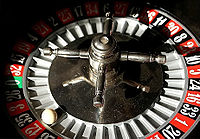 "exaggeration" when it came to representing the truth; in fact, he and his brother Louis once did some time in their native France for stock fraud.
"exaggeration" when it came to representing the truth; in fact, he and his brother Louis once did some time in their native France for stock fraud.Francois Blanc, the famous owner of the Beaux-Arts Casino in Monte Carlo, was a man who really appreciated the value of publicity. At the same time, he was not above a little
 "exaggeration" when it came to representing the truth; in fact, he and his brother Louis once did some time in their native France for stock fraud.
"exaggeration" when it came to representing the truth; in fact, he and his brother Louis once did some time in their native France for stock fraud.
We're relatively confident, however, that Blanc was not a willing accomplice in two storied instances when someone came in and "broke the back at Monte Carlo." On one of those occasions, it inspired a song that made it squarely into the popular culture.
First, it should be explained what it means to "break the bank" within this context. A gambler breaks the bank not when he exhausts all of the financial reserves of a casino (something that is virtually impossible in an establishment of any consequence) but when he wins more than the amount of chips that are currently at a table. At that point, at least at Monte Carlo, the game was closed, the table covered with a black shroud, and new chips brought in to re-fortify the game.
Charles Wells was a con man, plain and simple. He had been able to run a confidence game on unwitting investors who bought into inventions he touted that didn't really exist, What he did with the money was go on gambling sprees. One day in 1891 he walked into Monte Carlo and played the single-zero roulette wheel for anywhere from eleven to thirteen hours, and "broke the bank" a total of 12 times. His take from that session was approximately a million francs. Three months later he returned and turned the trick again, winning another million francs, at one point hitting the number 5 on five consecutive spins. So many other players sought to follow Wells at the roulette table that the casino had to limit the number of players allowed to be at the table with him.
All of this was quite mystifying, and the casino hired detectives to determine what went on, but they could never come up with an explanation as to how Wells had accomplished his gargantuan feat. Later Wells would explain that he was employing what was known as a "Martingale" system, in which bets are doibled up after losses, and had just gone on an extremely lucky streak.
Meanwhile, Wells had become famous virtually overnight, celebrated enough that songwriter Fred Gilbert penned the song "The Man Who Broke the Bank at Monte Carlo," which became one of the more popular tunes of the day, as it was sung by crooner Charles Coborn.
Wells was enjoying his fame and used it to bilk more people out of their cash. A year later he showed up again at Monte Carlo, the only legal spot for casinos in Europe at that time, with more investors' money, They had given it to him for his alleged invention, which was a device to help steam ships conserve fuel. At the start it looked as if Wells was on his way toward racking up another million francs. He actually broke the bank a few times, but the tide began to turn, and before he left Monaco, he had blown all the money he defrauded people out of.
On top of that, the law caught up to Wells. He was tried and convicted of fraud, and served eight years in prison. He would serve prison terms twice more for similar offenses before he died penniless in Paris at the age of 85.